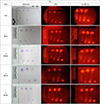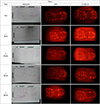Abstract
If we analogize any external physical force applied to victims of crimes involving violence, it would be possible to not only presume the mutual action between victims and suspects but also deduce more facts related to the cases. Therefore, in this study, defining the phenomenon of amino acid compounds in sweat spreading into clothes as impact marks, experiments using ninhydrin, 1,8-dizafluoren-9-one (DFO), 1,2-indanedione-zinc (1,2-IND-Zn) were conducted to determine developmental variations through change over time, which was not performed in previous studies. A 5-week period was set up including first damage as a variation factor, and materials in each action were developed using certain reagents. The level of specimen development depending on the change over time was identified. Thus, no changes were observed at each initial level of development.
Figures and Tables
 | Fig. 1It is a figure that processes pig skin to make the same condition as human skin. It is processed in the following steps and shows the process of opening, washing, and drying. |
 | Fig. 2It can be seen from the figure that we can see the appearance of the impulse measuring device used in the experiment and it consists of load cell and indicator. |
 | Fig. 3A photograph showing the signal exchange sequence of the impact amount measuring device, showing the information processing process of the machine. |
 | Fig. 4Through the 3D program, the experimenter visualized the posture of striking the specimen using a fist. This picture show the direction of the external force applied to the specimen at location and posture. |
 | Fig. 5Through the 3D program, the experimenter visualized the stance of striking the specimen using shoes. This picture show the direction of the external force applied to the specimen at location and posture. |
 | Fig. 6It is the result of an experiment that was hit using fist. No changes were observed in the test results from the beginning to the fourth week. DFO, 1,8-dizafluoren-9-one; 1,2-IND-Zn, 1,2-indanedione-zinc. |
 | Fig. 7It is the result of an experiment that was hit using shoes. No changes were observed in the test results from the beginning to the fourth week. DFO, 1,8-dizafluoren-9-one; 1,2-IND-Zn, 1,2-indanedione-zinc. |
 | Fig. 8As a result of observing the results of the initial and later experiments of the fist, no change was observed. DFO, 1,8-dizafluoren-9-one; 1,2-IND-Zn, 1,2-indanedione-zinc. |
References
1. Archer NE, Charles Y, Elliott JA, et al. Changes in the lipid composition of latent fingerprint residue with time after deposition on a surface. Forensic Sci Int. 2005; 154:224–239.
2. Public Prosecutors' Office. 2013 Analytical report on crimes. Seoul: Supreme Public Prosecutors' Office;2014. p. 295–301.
3. Hwang JJ. Collection of biological evidences at the crime scene. Korean J Leg Med. 2000; 24:103–107.
4. Van Lierde V, Chery CC, Moens L, et al. Capillary electrophoresis hyphenated to inductively coupled plasma-sector field-mass spectrometry for the detection of chromium species after incubation of chromium in simulated sweat. Electrophoresis. 2005; 26:1703–1711.
5. Choi MJ, Sun YS, Kim CS, et al. Study of sweat content and latent fingerprint developing. Anal Sci Technol. 2007; 20:147–154.
6. Croxton RS, Baron MG, Butler D, et al. Variation in amino acid and lipid composition of latent fingerprints. Forensic Sci Int. 2010; 199:93–102.
7. Hamer P, Price C. Case Report: a transfer from skin to clothing by kicking: the fetection and enhancement of shoeprints. J Forensic Sci Soc. 1993; 33:169–172.
8. Hong S, Kim C. Use of squid as an alternative to human skin for studying the development of hit marks on clothes. J Forensic Res. 2016; 7:351.
9. Lim HS, Song YE, Lee EB, et al. Study on the development of hit marks using a reaction reagent of amino acid. Korean J Forensic Sci. 2016; 17:82–86.
10. Kim HS. The effect of cold therapy application on pain and skin surface temperature upon injecting an intravenous needle (based on blood donors) [dissertation]. Incheon: Graduate School of Nursing, Gachon University of Medicine and Science;2010.
11. Kim WJ, Cheong JS. Discovering latent fingerprints from skin of carcass using pig skin. Korean Police Stud Assoc. 2012; 11:93–122.
12. Jeong IS. Development of an impact force measurement device with an attached strain gauge. Korean J Sport Biomech. 2012; 22:243–251.




 PDF
PDF ePub
ePub Citation
Citation Print
Print




 XML Download
XML Download